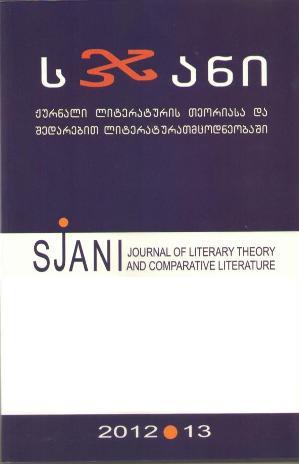წინ გასწრებული საათი ანუ ტრადიციისა და ნოვაციის სინთეზი ქართულ მოდერნისტულ ნარატივში
The Clock Ch ead of Time or The synthesis of Tradition and Novelty in Georgian Modernist Narrative
Author(s): Maia JaliashviliSubject(s): Literary Texts
Published by: ლიტერატურის ინსტიტუტის გამომცემლობა
Keywords: georgian culture; modernist; narration.
Summary/Abstract: Georgian culture, traditionally was considered within the “radius of world”. Processes that were going on in the art, and, first of all, in the literature, mainly, was a parallel and similar to the processes that took place in Europe. Literature followed its internal regularities and demonstrated such tendencies, which may have had any self-sufficient culture. Such openness of Georgian culture was limited somewhat in certain centuries. From the beginning of XX century, the artificial isolation has been prepared for disruption from inside. Archil Jorjadze’s articles in this view was excellent confirmation. His “aesthetism”, his point of view, which was oriented on European culture, preachment of mystical reality, exemption from the “social service restraints” of art, all of this created a completely different literary atmosphere. Kita Abashidze, who was fascinated of French Culture and followed the universal principle of “natural changeability”, thought that the appearance of symbolism was logically regular process in the Georgia literature. The scheme, which he created under the influence of Ferdinand Brunetière, french writer and critic, was not perfect, because it contained a lineata opinions. Nevertheless, Kita Abashidze’s writings, his support for a new generation had a great importance to the development of Georgian culture. The Symbolism was one of stream of Modernism. Gradually appeared in Georgia as well-known names in Europe such as Arthur Schopenhauer, Friedrich Nietzsche, Oscar Wilde, Wilhelm Wagner and others. The Scandinavian influence was evident in the creativity of Chola Lomtatidze, especially, August Strindberg’s and Knut Hamsun ‘s style. Nico Lortkipanidze had an influence of the Vienna School , especially, Arthur Schnitzler’s and p. Peter Altenberg’s style. This influence was not only meant an imitation, But the aspiration to create a new artistic, modernistic methods in Georgian literature. Great importance was also, that Vasil Barnov embodied the old Georgian syntax and thus made his narrative more stylized. A new generation of writers (among them, first of all, “The Blue Horns”, Gregory Robakidze, Konstantine Gamsakhurdia, and others), not impulsive, but consciously applied to experiments. Modernism meant primarily to introduce novelty. This process entailed the entire Georgian culture. That is why this process was called by Grigol Robakidze as Renaissance of Georgian Culture. In general, the two high flow was in a half of XX century in the Georgian Literature: on the one hand, Modernism, with its various branch (Symbolism, Impressionism, Expressionism, Futurism), and, on the other hand, Neorealism of Javakhishvili’s prose, which was demonstrating the pulse of the epoch.
Journal: სჯანი
- Issue Year: 2012
- Issue No: 13
- Page Range: 176-184
- Page Count: 9
- Language: Georgian

